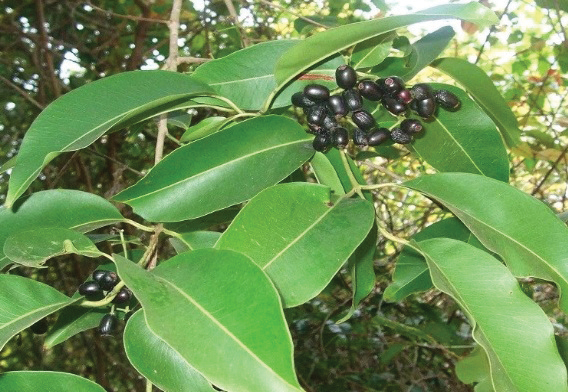Jamboo (Syzygium cumini)
This tree is commonly known as jamun in Hindi and jambolan/black plum in English. It belongs to the family Myrtaceae and Mutra Sangrahaniya Gana in Ayurveda.
It is known to have grown in the Indian sub-continent, and many other adjoining regions of South Asia such as India, Bangladesh, Burma, Nepal, Pakistan, Sri Lanka and Indonesia. It was long ago introduced into and became naturalized in Malaysia. In southern Asia, the tree is venerated by Buddhists, and it is commonly planted near Hindu temples because it is considered sacred to Lord Krishna.
Plant description: It is a large evergreen and densely foliaceous tree with greyish-brown thick bark, exfoliating in woody scales. The wood is whitish, close grained and durable; affords brown dyes and a kind of a gum kino. The leaves are leathery, oblong-ovate or elliptic with 6 to 12 centimeters long and shining with numerous nerves uniting within the margin. The inflorescence are borne mostly from the branchlets below the leaves, often being axillary or terminal, and are 4 to 6 centimeters long. Flowers are scented, greenish-white, in clusters of just a few or 10 to 40 and are round or oblong. The fruits are berries and are often obviously oblong, 1.5 to 3.5 centimeters long, dark-purple or nearly black, luscious, fleshy, and edible; it contains a single large seed. The dark violet colored ripe fruits give the impression the fruit of the olive tree both in weight and shape and have an astringent taste. The fruit has a combination of sweet, mildly sour and astringent flavor and tends to color the tongue purple.
Ayurvedic pharmacology: Guna- Laghu, Ruksha; Rasa- Kashaya, Madhur, Amla; Vipaak- Katu; Veerya- Sheeta
Chemical composition: It contains anthocyanins, glucoside, ellagic acid, isoquercetin, kaemferol and myrecetin. The seeds contain alkaloid, jambosine, and glycoside jambolin or antimellin and is also rich in flavonoids, a well-known antioxidant.
Therapeutically useful parts: Fruits, seeds, leaves and bark.
Therapeutic uses: The bark is anthelmintic and used for the treatment of sore throat, bronchitis, asthma, thirst, biliousness, dysentery, intestinal parasites and ulcers. The fruit is diuretic. The seed is good for diabetes. The ash of the leaves is used for strengthening the teeth and gums. Juice of tender leaves alone or in combination with carminatives such as cardamom or cinnamon is given in goat’s milk to treat diarrhea in children.
Doses: Juice- 10 to 20 ml, Powder- 3 to 6 grams.
Dr. Pratibha Mamgain, Department of Ayurvedic Medicine

